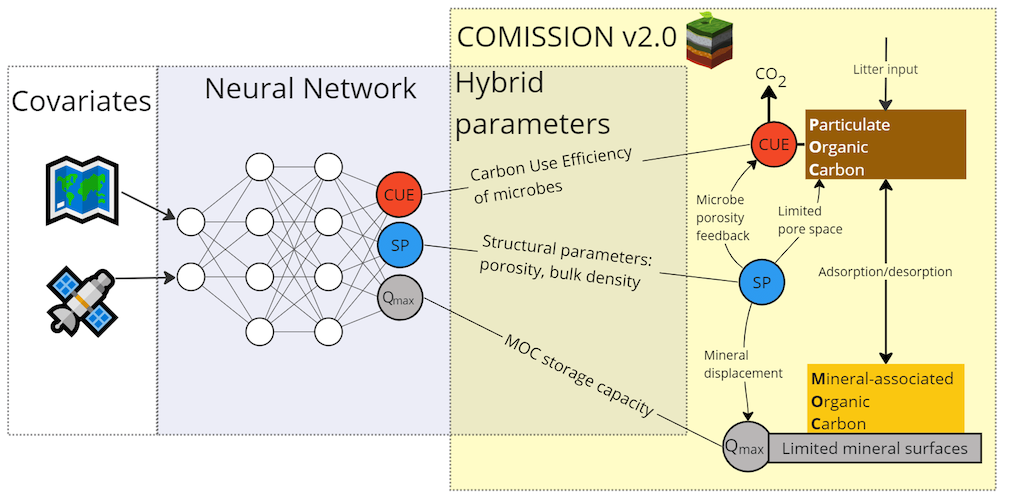PhD project offered by the IMPRS-gBGC in July 2023
Combining process-based and deep learning models to understand soil processes better |
|
Bernhard Ahrens
,
Thomas Wutzler
,
Marion Schrumpf
,
Markus Reichstein
,
Anke Hildebrandt
|
Project descriptionMachine learning has become a mainstay in Earth sciences and digital soil mapping. Projects like soilgrids.org have used machine learning to estimate soil organic carbon, soil porosity, and bulk density from soil profile measurements worldwide. However, the black-box nature of machine learning hinders understanding how soil organic carbon interacts with soil structural variables such as soil porosity and bulk density.In this project, we will combine the data-adaptiveness of deep learning and the wealth of knowledge incorporated in mechanistic soil organic carbon models with the aim of better understanding how bulk density, porosity and soil organic carbon co-evolve. Our starting point will be the COMISSION model (Ahrens et al., 2020), a mechanistic soil organic carbon model with microbial and mineral interactions. It conceptualises soil organic carbon into different pools, which can be grouped into particulate and mineral-associated organic carbon. COMISSION uses an analytical model for bulk density to model the displacement of mineral soil by organic matter. A dynamic model for porosity based on the same principles (Robinson et al., 2022) can be a vital extension to the COMISSION model, which allows considering the feedback of soil structure on microbial processes. There is a long-lasting debate whether there is an upper limit for soil organic carbon storage (Begill et al., 2023, Hassink, 1997, Stewart et al., 2007). So far, the debate has mostly centred around the capacity of minerals to form mineral-associated organic carbon but soil porosity, which can be a fundamental upper limit for soil organic carbon storage, has been underexplored. Similarly underexplored is the displacement of mineral soil by organic matter, which reduces the capacity of soils to form mineral-associated organic carbon. By combining mechanistic models with deep learning into so-called hybrid models (Reichstein et al., 2019), this project aims to improve our understanding of the interplay of bulk density, porosity, soil organic carbon storage and its potential upper limits (Figure 1). Large-scale datasets will be used for parameter learning of the dynamic model of soil structure and soil organic carbon. The prospective PhD student is encouraged to explore their own ideas within the hybrid modelling framework of soil organic carbon and soil structure. Working groupThe Max Planck Institute for Biogeochemistry in Jena offers an exceptionally dynamic, creative, international, and multidisciplinary working environment. The successful applicant will join the Soil Biogeochemistry group, which encompasses experimental and theoretical work on the persistence and sensitivity of organic carbon in soils and interactions between biogeochemical cycles of carbon, nutrients, and water at all spatial scales. The project will be conducted in close collaboration with the MPI-USMILE group on Understanding and Modelling the Earth System with Machine Learning. For further information, please contact Bernhard Ahrens, Thomas Wutzler, Marion Schrumpf, Markus Reichstein and Anke Hildebrandt.Requirements for the PhD project areWe welcome applications from curious and motivated students from any country who have
ReferencesAhrens B, Guggenberger G, Rethemeyer J et al. (2020) Combination of energy limitation and sorption capacity explains 14C depth gradients. Soil Biology and Biochemistry, 148, 107912.Begill N, Don A, Poeplau C (2023) No detectable upper limit of mineral?associated organic carbon in temperate agricultural soils. Global Change Biology. Hassink J (1997) The capacity of soils to preserve organic C and N by their association with clay and silt particles. Plant and Soil, 191, 77-87. Reichstein M, Camps-Valls G, Stevens B, Jung M, Denzler J, Carvalhais N, Prabhat (2019) Deep learning and process understanding for data-driven Earth system science. Nature, 566, 195-204. Robinson DA, Thomas A, Reinsch S et al. (2022) Analytical modelling of soil porosity and bulk density across the soil organic matter and land-use continuum. Scientific Reports, 12. Stewart CE, Paustian K, Conant RT, Plante AF, Six J (2007) Soil carbon saturation: concept, evidence and evaluation. Biogeochemistry, 86, 19-31.  Figure 1: Hybrid modelling framework that links machine learning (Neural Network in figure) and a mechanistic soil organic carbon and soil structure model through learning of hybrid mechanistic parameters. |